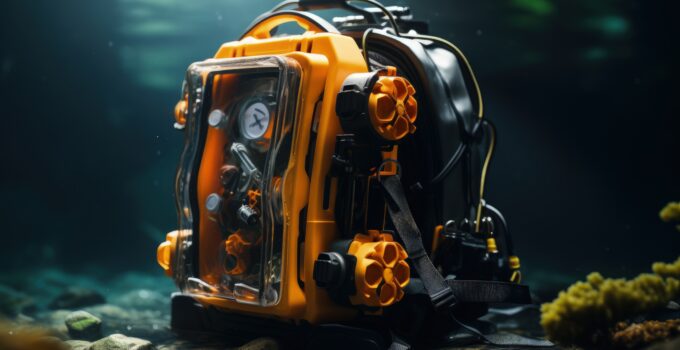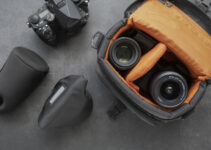Are underwater camera bags safe? Ensuring the safety of expensive camera equipment during aquatic adventures is paramount for photographers.
Underwater camera bags offer a protective barrier against water damage, allowing photographers to capture stunning images in challenging environments.
These specialized bags are designed to be waterproof, keeping cameras and accessories dry and functioning even in submerged conditions.
However, their effectiveness depends on proper sealing and use according to manufacturer instructions.
Here 7 travelling hack
Understanding the limitations and features of underwater camera bags ensures that photographers can confidently explore underwater photography while safeguarding their valuable gear.
Are underwater camera bags safe?
Underwater camera bags can be safe if used correctly and if they are of good quality.
These bags are designed to protect your camera from water damage while allowing you to operate it underwater.
Key factors to ensure safety include checking the bag’s waterproof rating, ensuring proper sealing before submersion, and testing it with a substitute item (like tissue paper) before trusting it with your camera.
It’s crucial to follow manufacturer instructions meticulously, as improper sealing or exceeding depth limits can compromise protection.

Additionally, inspect the bag regularly for wear and tear, and avoid exposing it to extreme temperatures or sharp objects that could damage its integrity.
With careful usage and maintenance, underwater camera bags can provide reliable protection for your camera gear in aquatic environments.
How to pack an underwater camera for travel?
Packing an underwater camera for travel requires careful consideration to ensure it remains safe and functional during transit.
Start by cleaning and drying your camera and lenses thoroughly to prevent any moisture buildup inside the camera bag.
Remove batteries and memory cards to prevent accidental activation or damage. Invest in a sturdy, waterproof camera bag or case designed specifically for underwater equipment.
Use silica gel packs or moisture-absorbing packets inside the bag to further protect against humidity.
Securely pack additional accessories like chargers, extra batteries, and lens cleaning tools in a separate compartment within the bag.
Ensure the camera bag fits snugly in your larger luggage and is cushioned with soft items to prevent impact damage.
Lastly, carry important documentation such as warranty information or manuals for quick reference if needed. By following these steps, you can ensure your underwater camera remains safe and ready for action throughout your travels.
Does a camera bag protect the camera?
How can I protect my camera underwater?
To protect your camera underwater, use a dedicated underwater camera housing or bag that is rated for the depths you intend to dive.
Ensure all seals are tight and inspect them before each use. Use silica gel packs inside the housing to absorb moisture.
Avoid sudden temperature changes when moving between water and air. Rinse your camera and housing with fresh water after each dive to remove salt and debris.
Store your camera in a cool, dry place with adequate ventilation to prevent mold and corrosion. Regularly check and maintain seals and O-rings as per manufacturer instructions to ensure continued waterproofing.
How to make a camera bag waterproof?
Is it imporatnt to know are underwater camera bag safe?
Yes, it is crucial to know if underwater camera bags are safe because their effectiveness directly impacts the protection of your valuable camera equipment.
Understanding their safety features helps in making informed decisions about their use in underwater environments.
Key considerations include the bag’s waterproof rating, build quality, and the reliability of seals and closures.
Properly sealed and maintained bags can provide effective protection against water damage, allowing you to confidently use your camera underwater without risking costly repairs or loss of equipment.
Additionally, knowing safety precautions such as depth limits, testing procedures before use, and regular maintenance routines ensures the bag remains reliable over time.
Ultimately, being informed about the safety of underwater camera bags empowers photographers to enjoy underwater photography with peace of mind, knowing their gear is adequately protected against the elements.
7 tips to know how to safely use camera bag under water?
Are underwater camera bags safe to use
Underwater camera bags can be safe to use if they are designed and used correctly.
The safety of these bags primarily depends on their construction quality, waterproofing capabilities, and the user’s adherence to proper usage guidelines.

High-quality underwater camera bags are typically made from durable, waterproof materials like PVC, TPU, or neoprene, with reliable seals and closures to prevent water from entering.
It’s essential to choose a bag that matches the depth and environmental conditions you intend to use it in, adhering strictly to manufacturer specifications regarding depth ratings and usage limits.
Regular inspection and maintenance of seals and closures are also critical to ensuring continued waterproofing and protection of your camera equipment.
When used correctly and maintained properly, underwater camera bags can provide effective protection against water damage, allowing photographers and videographers to capture stunning images and footage in aquatic environments with peace of mind.
Are underwater camera bags safe for snorkeling?
Underwater camera bags can generally be safe for snorkeling, provided they are specifically designed for underwater use and used within their specified depth limits.
When choosing a bag for snorkeling, opt for one with a sufficient depth rating that matches or exceeds the depths you plan to snorkel at.
These bags are typically designed to withstand the pressures and conditions encountered while snorkeling, such as splashing water and occasional submersion.
To ensure safety while snorkeling with a camera bag, thoroughly inspect the bag for any signs of wear or damage before each use.
Test the seals and closures to ensure they are secure and waterproof.
Additionally, practice proper handling techniques underwater to minimize the risk of accidental impacts against rocks or other surfaces that could damage the bag or camera equipment inside.
Following manufacturer guidelines and using the bag as intended can help mitigate risks, ensuring your camera remains protected while capturing underwater moments during snorkeling adventures.
Best waterproof camera bag for kayaking
Has anyone bought underwater/waterproof cases for their DSLRs before? Would you recommend doing it?
Many photographers invest in underwater or waterproof cases for their DSLRs to capture high-quality images in aquatic environments.
These cases provide a protective barrier against water, allowing photographers to submerge their cameras safely. Whether to purchase one depends on your specific needs and photography style.
If you frequently shoot underwater or in wet conditions, investing in a quality waterproof case can expand your creative possibilities without risking damage to your expensive DSLR equipment.
However, it’s essential to choose a case that matches your camera model and is rated for the depths you plan to dive or snorkel. Look for reputable brands known for their waterproofing capabilities and durability.
Additionally, consider factors like ease of use, access to camera controls, and maintenance requirements.
Here, how to spot a fake ysl lou camera bag?
Overall, if underwater photography is a significant part of your photography pursuits, purchasing a reliable underwater or waterproof case can be a worthwhile investment to protect and enhance your DSLR camera’s versatility.
I just got a go pro to use while underwater and I’m worried about weather it’s actually water proof or not, can someone let me know if I need a case or anything for it before use? Thanks in advance
The GoPro cameras are generally designed to be waterproof without the need for an additional case for shallow water activities.
Most recent models, like the GoPro HERO10 or HERO9, are waterproof up to 33 feet (10 meters) without a housing. This means you can use them safely for snorkeling, swimming, and other surface-level underwater activities without worrying about water damage.

However, if you plan to use your GoPro for deeper dives or in more extreme underwater conditions, it’s advisable to use a waterproof housing or case.
These accessories can provide additional protection against water pressure and potential impacts, ensuring your GoPro remains safe and functional in more challenging environments.
Always ensure that the seals and closures of any housing or case are properly maintained and tested before each use to prevent leaks.
Following manufacturer guidelines and recommendations will help you make the most of your GoPro’s waterproof capabilities while keeping it safe underwater.
Related faq’s
Is Dicapac underwater housing safe for your DSLR?
Dicapac underwater housings are generally safe for DSLRs when used correctly and within their specified depth ratings.
They are designed to provide waterproof protection for DSLR cameras during underwater photography and other wet conditions.
However, like any underwater housing, it’s crucial to follow manufacturer guidelines precisely, including checking seals and closures before each use, adhering to depth limits, and performing regular maintenance.
Proper care and handling ensure that the Dicapac housing effectively protects your DSLR from water damage, allowing you to capture stunning underwater images with peace of mind.
Here, how to make a fanny pack camera bag?
Does putting your phone in a ziploc bag make it safe to take pictures underwater?
Putting your phone in a Ziploc bag can provide limited protection against water while taking pictures underwater.
However, Ziploc bags are not designed for prolonged submersion or underwater use, and their effectiveness can vary.
They may not provide a completely watertight seal, especially under pressure or if submerged for extended periods.
For more reliable underwater photography, it’s recommended to use dedicated waterproof cases or housings designed specifically for your phone model.
These cases offer better protection against water ingress and ensure your phone remains safe and functional while capturing underwater photos.
Do underwater cameras need housing?
Yes, underwater cameras typically need housing to protect them from water damage.
While some cameras are designed with waterproof features for shallow depths, such as splash-proofing or resistance to light rain, dedicated underwater photography requires specialized housings.
These housings provide a sealed environment that keeps the camera safe from water pressure and ingress during deeper dives or prolonged submersion.
They also allow full control of camera functions underwater, including accessing buttons and adjusting settings.
Using the appropriate housing ensures that your underwater camera remains operational and protected, enabling you to capture high-quality images and videos in aquatic environments with confidence.
I want to record videos underwater, but all I have is my phone. Is it safe to put my phone in a Ziploc bag to waterproof it? What if I put that bag inside another Ziploc bag? Will that affect the video quality?
Putting your phone in a Ziploc bag can provide some protection against water, but it’s not guaranteed to be completely waterproof, especially for extended underwater use or deeper depths.
Adding another Ziploc bag may offer additional protection, but it’s still not as reliable as a dedicated waterproof case or housing designed for your specific phone model.
The double-bagging approach might affect video quality due to potential distortion or interference with touch screen responsiveness and camera lens clarity.
Here does camera bag count as a carry on amercian airline?
For better results and to ensure your phone’s safety while recording underwater videos, consider investing in a quality waterproof case or housing tailored for your phone.
Conclusion:
Underwater camera bags can provide effective protection for camera equipment when used correctly and maintained properly.
Their safety hinges on factors such as quality construction, reliable seals, and adherence to depth ratings.
Regular inspection and care ensure continued waterproofing and safeguard against water damage during underwater photography or other wet conditions.
Choosing a reputable brand and following manufacturer guidelines are crucial steps to maximize the safety and longevity of underwater camera bags, allowing photographers to capture stunning images with confidence in aquatic environments.







